AI overviews are AI-generated summaries that show up at the top of Google Search results. They help users quickly grasp complex topics and improve website navigation, but they also have come with some major issues and headaches for users, and some pretty hilarious and outlandish overviews. These results are powered by Google’s large language model (LLM) – Gemini.
Introduction
During one of your recent Google searches, you’ve probably noticed the AI overview at the top of the results page. These AI-generated summaries are supposed to help you quickly grasp complex topics without having to visit multiple websites. Powered by Google’s Gemini large language model (LLM), along with Generative AI.
Liz Reid VP, Head of Google Search
But as convenient as they are, AI Overviews come with their own set of challenges and considerations. In this article, we’ll explore how these overviews work, their key benefits, practical tips for optimizing your website for them, and some of the hurdles Google faces in making these overviews as accurate and helpful as possible.
How do AI Overviews Work?
Through our team’s analysis and research, alongside Google’s announcements, we’ve discovered the following about AI Overviews:
- Google’s Gemini is at the core of these search overviews – a large language model acclaimed for its human-like information synthesis.
- These “AI overviews” are not just a random assembly of facts; they are carefully curated responses designed to address the user’s query with precision and depth.
- They draw from a myriad of web pages to present a well-rounded perspective.
- They have presented many issues and completely wrong search results.
Thanks to Gemini’s prowess in multi-step reasoning and multimodality, users are treated to search results that are not only relevant but also contextually rich, marking a significant leap from traditional search results. With additional triggering refinements, Gemini ensures an enhanced search experience for users.
Here’s an interview Sundar Pichai did with the Verge regarding the future of AI search!
Here are some key takeaways from the interview:
- 🤖 He emphasizes the importance of balancing AI-generated content with ensuring high-quality and valuable information for users.
- 🔍 The challenges of maintaining accuracy and factuality in AI-generated content are recognized, with ongoing efforts to address these issues.
- 💡 One of the biggest challenges is how to reward originality, creativity, and independent voice in the content ecosystem.
What do AI overviews look like?
Here is an example for when you search for “What are Google AI overviews?”
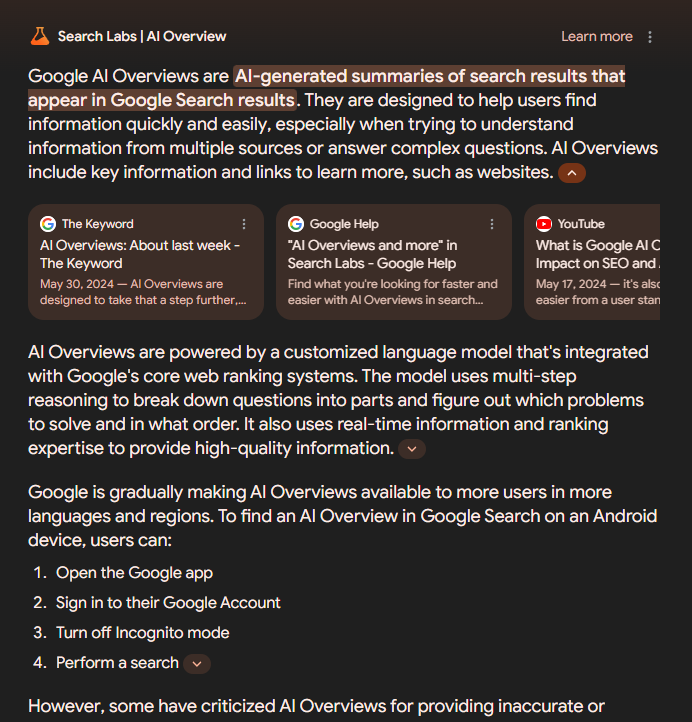
Here is an example for when you search for “History of Pumpkin Pie”
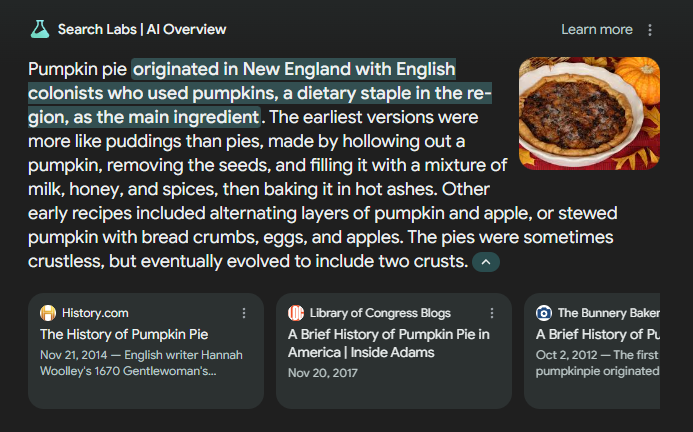
How AI Overviews Impact Search Results
Integrating AI Overviews into Google Search results signifies a considerable departure from the conventional search experience. Users are no longer required to sift through pages upon pages of content to find the kernel of information they seek. Instead, AI Overviews present a bird’s-eye view of a topic, distilled into a quick overview that highlights key points and provides links for those who wish to explore further.
How to sign up and enable AI Overviews
Search Labs
Go to Google Search Labs at – labs.google.com

Scroll down and you’ll see a section called “AI Overview in Search”
Click “Get Started“
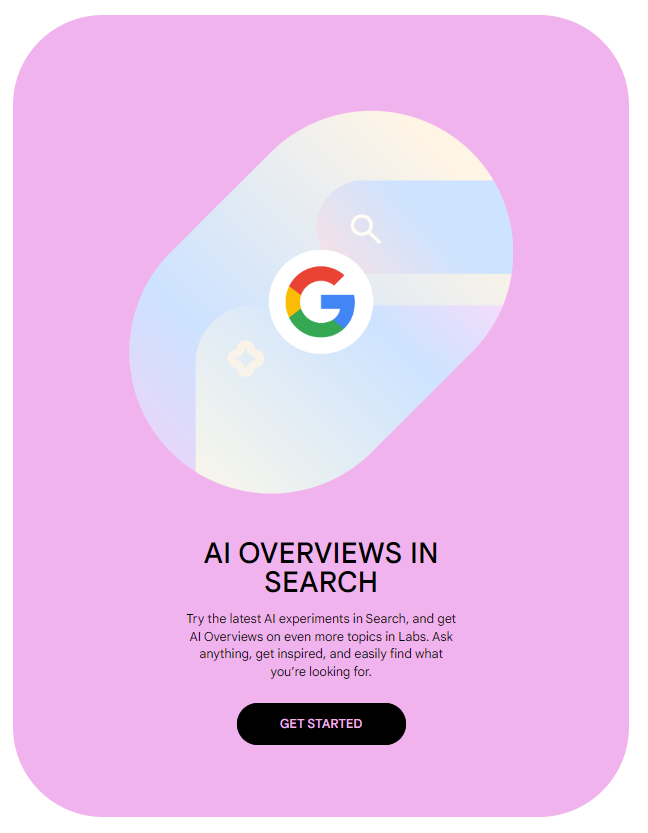
AI Overviews should now be enabled.
Customizing AI Overviews
Google has introduced several options to tailor AI Overviews to meet individual needs, ensuring that users get the most relevant and comprehensible information possible. One notable feature is the ability to adjust the complexity of the language used in the summaries. This means that whether a user prefers simple, straightforward explanations or more technical, detailed descriptions, the AI can cater to their preference.
Additionally, Google has implemented a “break it down” button, which allows users to control the granularity of the details provided. With this button, users can request more detailed breakdowns of complex topics or choose to condense information into more digestible summaries. This feature is particularly useful for users who need a deeper understanding of specific aspects of a topic or those who are in a hurry and prefer quick overviews.
Moreover, these customization options are designed to be intuitive and user-friendly, making it easy for anyone to adjust the AI Overviews to their liking with just a few clicks. By providing these tailored options, Google aims to enhance the user experience, making information more accessible and useful for a diverse range of users with varying needs and preferences.
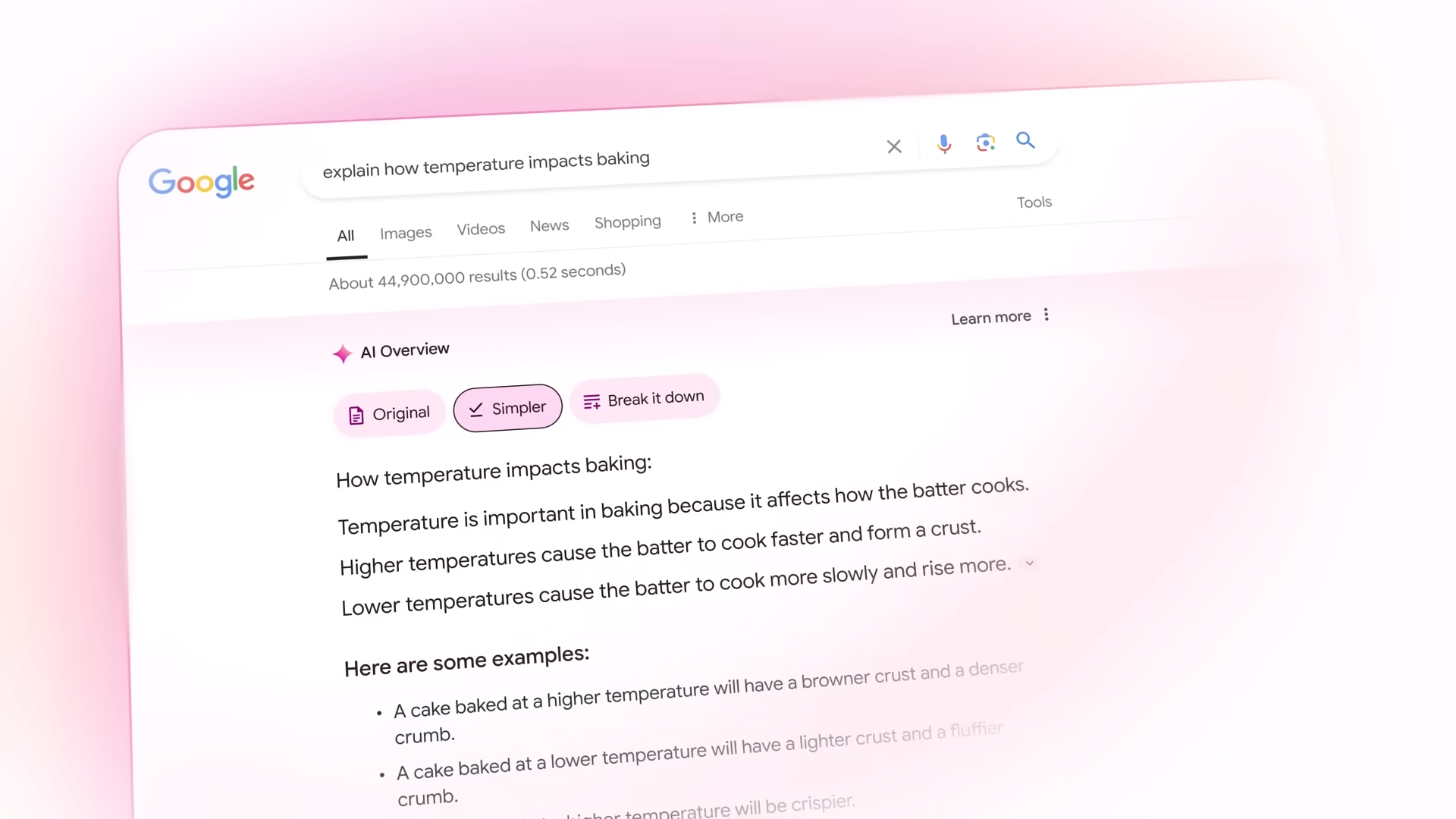
Preventing Content from Appearing in AI Overviews
Although AI Overviews are most likely here to stay, and will shape the future of search on the internet, website owners and publishers may sometimes prefer to not have their content scraped and presented in an overview. Enter preview controls: a suite of options that Google has released to empower website owners to specify which content should remain outside the realm of AI Overviews.
If you’re dead set on trying to block your page from appearing in these results, the officially suggested method is using a robots.txt file, and then “disallowing” Googlebot from your website.
Add this to your robots.txt file:
User-agent: Googlebot
Disallow: /Make sure to place the robots.txt file in the root directory of your website (e.g., https://www.yourwebsite.com/robots.txt) for it to be effective.
⚠️ WARNING: This will permanently block Google from crawling your website as long as this snippet is found in your robots.txt file. YOU WILL ESSENTIALLY DESTROY ANY SEO VALUE YOUR WEBSITE CURRENTLY HAS.
Leveraging Generative AI for Complex Questions
The introduction of generative AI in Google Search signifies a fundamental change in our approach to complex questions. No longer confined to the restrictive bounds of simple queries, users can now:
- Pose multifaceted questions
- Receive answers that are not just comprehensive but also conversational in nature
- Benefit from the seamless interplay of context and content.
This advancement is not only a boon for user satisfaction but also an invitation for website owners to engage audiences with content that addresses more complex inquiries, thereby establishing authority and depth in their respective domains.
Issues with Google AI Overviews
While Google AI Overviews aim to enhance user experience by providing quick and concise summaries of web content, they are not without their drawbacks. These AI-generated summaries have been subject to several issues that raise significant concerns among users and content creators alike. In this section, we will delve into the various problems associated with Google AI Overviews, including copyright implications, accuracy issues, and potential harm caused by misleading information.
Copyright Implications of AI Overviews
One of the most contentious aspects of AI Overviews is the copyright implications of displaying website content that Google scrapes without explicit permission from the content creators. This practice can prevent users from visiting the original website, potentially impacting the site’s traffic and revenue. Here’s a deeper dive into the copyright concerns and their implications:
Unauthorized Content Use
Google’s AI Overviews operate by scraping and summarizing content from various websites. This process often happens without explicit consent from the content creators. While Google argues that its use falls under the fair use doctrine, which allows limited use of copyrighted material without permission for purposes such as commentary, criticism, news reporting, and research, this interpretation can be contentious. Content creators might argue that:
- Loss of Traffic: By providing key information directly on the search results page, AI Overviews can reduce the number of clicks through to the original website, potentially leading to a significant loss in ad revenue and visitor engagement.
A notable example of this issue is The Weather Network, which experienced a significant drop in traffic when Google began displaying weather information directly in search results.
- Content Misrepresentation: Summarizing complex information into brief overviews can sometimes misrepresent the original content, leading to misunderstandings or the spread of inaccurate information. This misrepresentation can harm the reputation of the original content creator.
Fair Use vs. Infringement
The debate over whether Google’s use of scraped content constitutes fair use or infringement centers on several factors:
- Purpose and Character: Google may claim that its purpose is to provide a transformative use of the content by creating a new, concise summary that helps users quickly find relevant information. However, content creators may argue that this use is not sufficiently transformative and instead replaces the need to visit the original content.
- Nature of the Work: Factual content is more likely to be considered fair use than creative content. Since AI Overviews often summarize factual information, Google might have a stronger case. However, the context and originality of the presentation also matter.
- Amount and Substantiality: Even though the summaries are brief, they often contain the “heart” of the content, which can be a critical factor against fair use. If the most valuable parts of the content are used, it might lean towards infringement.
- Effect on the Market: The potential loss of traffic and revenue can have a significant effect on the market for the original content, which is a crucial factor against fair use.
Legal and Ethical Considerations
- Legal Recourse: Content creators can pursue legal action if they believe their content is being used without permission and not under fair use. This can lead to lengthy and costly legal battles. The evolving nature of digital content and AI technologies makes the legal landscape complex and fluid.
- Ethical Practices: Beyond legal implications, there are ethical considerations regarding respect for intellectual property. Content creators invest time and resources into creating valuable content, and it is ethically problematic to use their work without proper attribution or compensation.
Steps for Content Creators
- Opt-Out Options: Website owners can use tools like the robots.txt file to prevent search engines from scraping their content. However, this also means their content will not appear in search results, which can reduce visibility.
- Watermarking and Attribution: Implementing clear attribution practices and possibly watermarking content can help ensure that the source is always visible, even in summaries.
- Legal Consultation: Seeking legal advice to understand rights and options can help content creators protect their intellectual property effectively.
Using AI Overviews to Drive Traffic to Your Website
Now that these AI overviews are rolling out to everyone, and they appear at the top of the results, you almost have no choice but to optimize your site to appear in them. Optimizing your site for these overviews can significantly amplify organic traffic as users are more likely to click on links embedded within these concise summaries compared to traditional search listings.
Optimizing Content for AI Overviews
Optimizing for AI Overviews begins by adhering to Google’s proven search guidelines. By embracing structured data and focusing on topic-centric content, creators can signal the relevance and authority of their resources, increasing the likelihood of being featured in these powerful summaries.
Furthermore, consider adding multimedia elements and internal links, as these can not only enhance the user experience but also provide clear pathways for AI to understand and showcase your content.
Utilizing AI Tools for Enhanced Visibility
With the digital landscape continually changing, maintaining a competitive edge requires a consistently proactive approach to content relevance. AI tools can serve as your vigilant sentinels, analyzing trends and providing real-time insights that enable you to:
- Refine your content strategy on the fly
- Stay ahead of the competition
- Identify emerging trends
- Optimize your content for maximum impact
By leveraging AI tools, and working with an AI consulting company you can ensure that your content remains relevant and engaging in today’s fast-paced digital world.
From keyword analyzers to performance monitors, these intelligent systems are the allies you need to ensure your website shines brightly in the crowded online marketplace.

Common Issues and Solutions with AI Overviews
Despite the hard work of algorithms and models, the digital world isn’t free from glitches. AI Overviews are designed with robust mechanisms to minimize inaccuracies, but should you encounter persistent issues, there are avenues for resolution.
Engaging with fact-checking algorithms and seeking support from the Google Search Central Help Community can be effective steps in troubleshooting any challenges that arise.
Feedback and Continuous Improvement
The symbiotic relationship between AI and user feedback propels ongoing improvements in search overviews. Each interaction with an AI Overview is an opportunity to fine-tune the system, ensuring that the summaries remain accurate, relevant, and reflective of the diverse tapestry of users they serve. By engaging in a productivity chat, users can contribute valuable insights to enhance the AI’s performance.
Feedback is not just welcomed; it is essential for the evolution of these tools, helping to sharpen their accuracy and expand their inclusivity with each iteration.
As these features become increasingly integrated into the search ecosystem, they represent a new chapter in how we interact with the vast knowledge available online.
Frequently Asked Questions
How to enable AI overview?
To enable AI overview, open Chrome, make sure you’re signed in, click New tab, then go to Labs and toggle on “AI Overviews and more.”
What are AI overviews?
AI Overviews encapsulate Google’s expertise in processing and presenting information. They are the result of the Gemini model’s ability to generate natural-sounding answers to a wide array of questions. Users can encounter these AI-generated summaries across Google searches, offering a snapshot of information that is both comprehensive and accessible.
How do AI Overviews work within Google Search?
AI Overviews in Google Search are generated by the Gemini model, which consolidates information from different sources to provide users with a quick and comprehensive understanding of a topic. They appear in search results to enhance the user’s understanding of complex information.
Do I need to do anything special to have my website’s content included in AI Overviews?
No, you don’t need to take any special actions for your website’s content to be included in AI Overviews. Just make sure your content follows Google Search Essentials to increase the chances of inclusion.
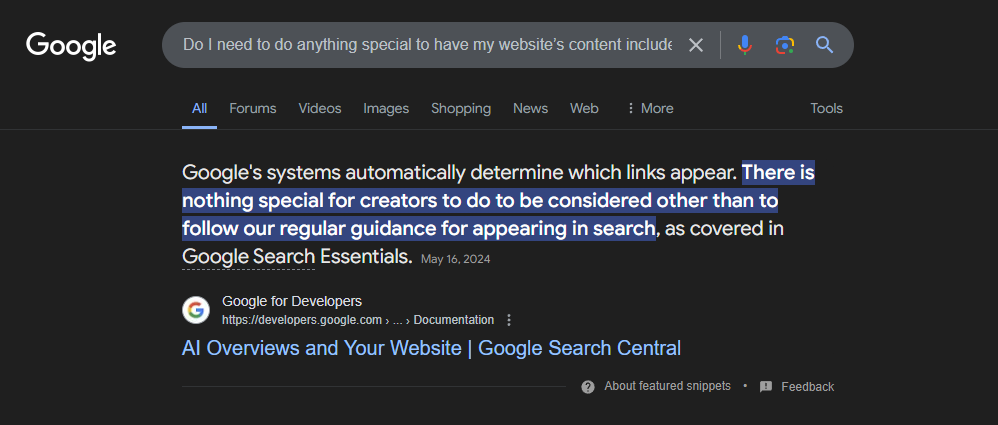
Here is a quote directly from Google Search Central regarding which content get’s chosen to appear in AI overview results:
Google Search Central
Can I prevent certain content from my website from appearing in AI Overviews?
Yes, you can prevent certain content from appearing in AI Overviews by using preview controls like robots.txt, ensuring they are correctly implemented and visible to Googlebot.
Add this to your robots.txt file:
User-agent: Googlebot
Disallow: /Make sure to place the robots.txt file in the root directory of your website (e.g., https://www.yourwebsite.com/robots.txt) for it to be effective.
⚠️ WARNING: This will permanently block Google from crawling your website as long as this snippet is found in your robots.txt file. YOU WILL ESSENTIALLY DESTROY ANY SEO VALUE YOUR WEBSITE CURRENTLY HAS. If you’re unsure what you’re doing, we highly suggest reaching out and we can help you out.
What benefits do generative AI and AI Overviews bring to complex questions in search?
Generative AI and AI Overviews bring the benefit of enabling users to ask and receive answers to more complex questions in a conversational manner, leading to higher satisfaction with search results and encouraging users to ask more detailed questions.
1 comment
I’ve had some hilarious overviews. I saw one where Google suggested I add glue to my pizza to make it cheesier.